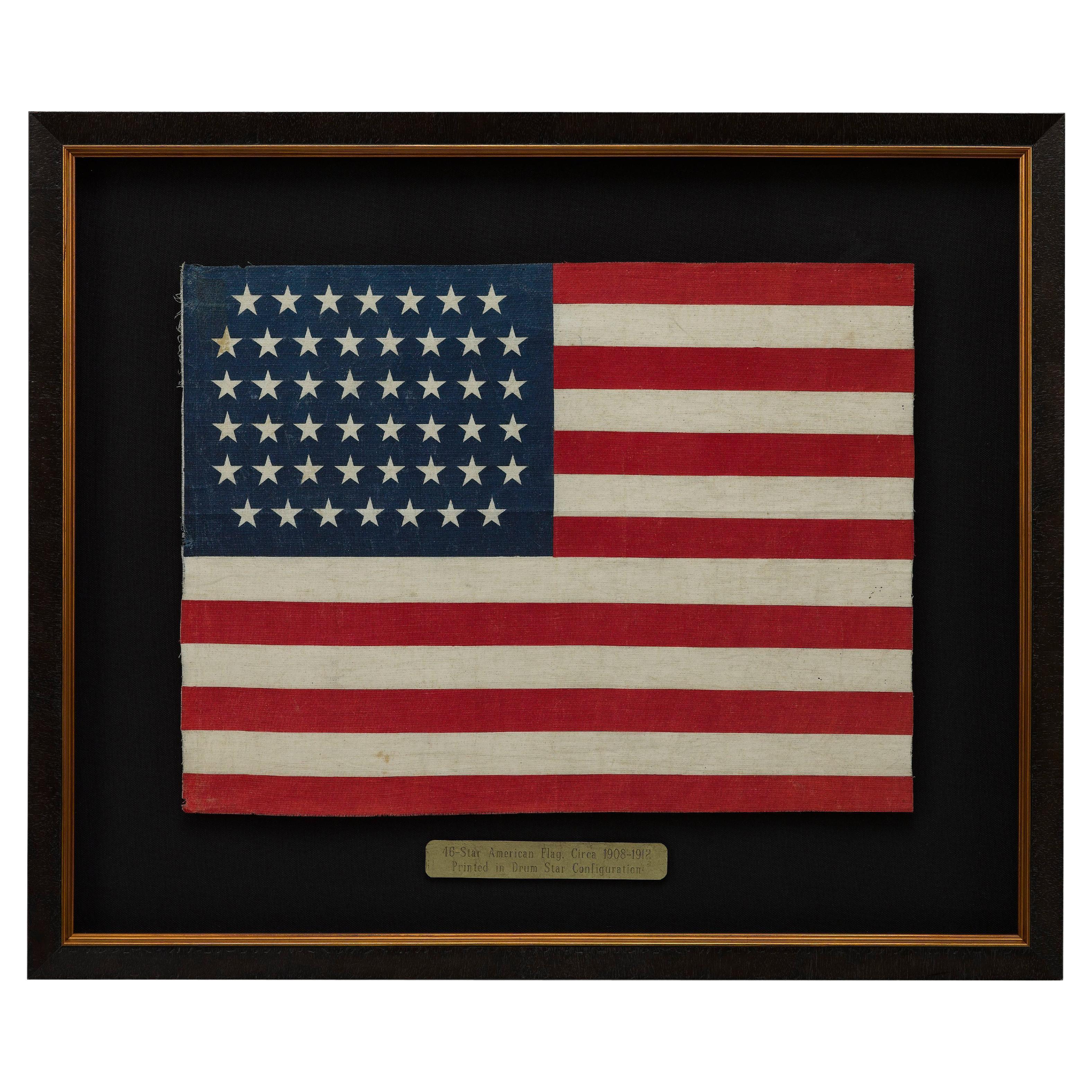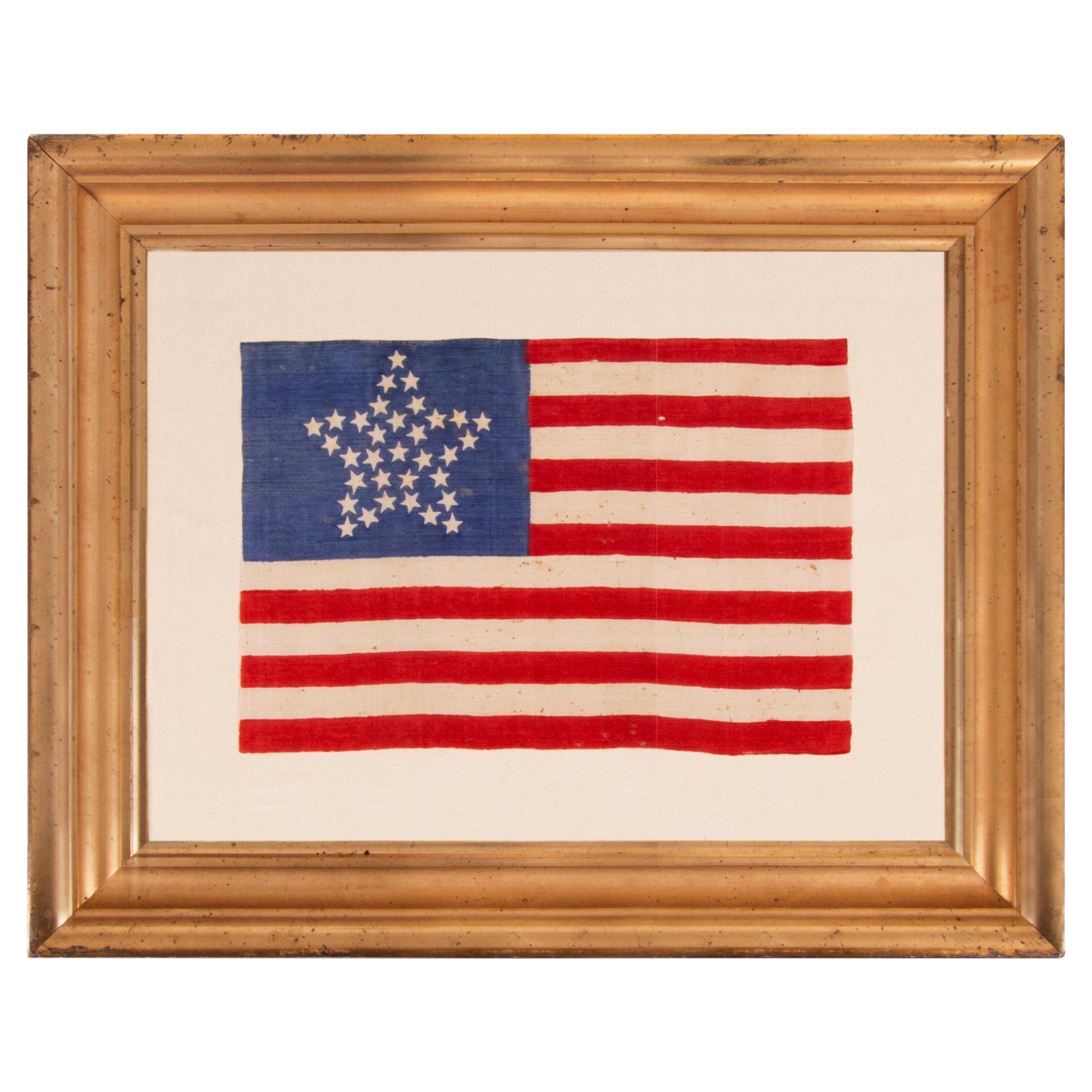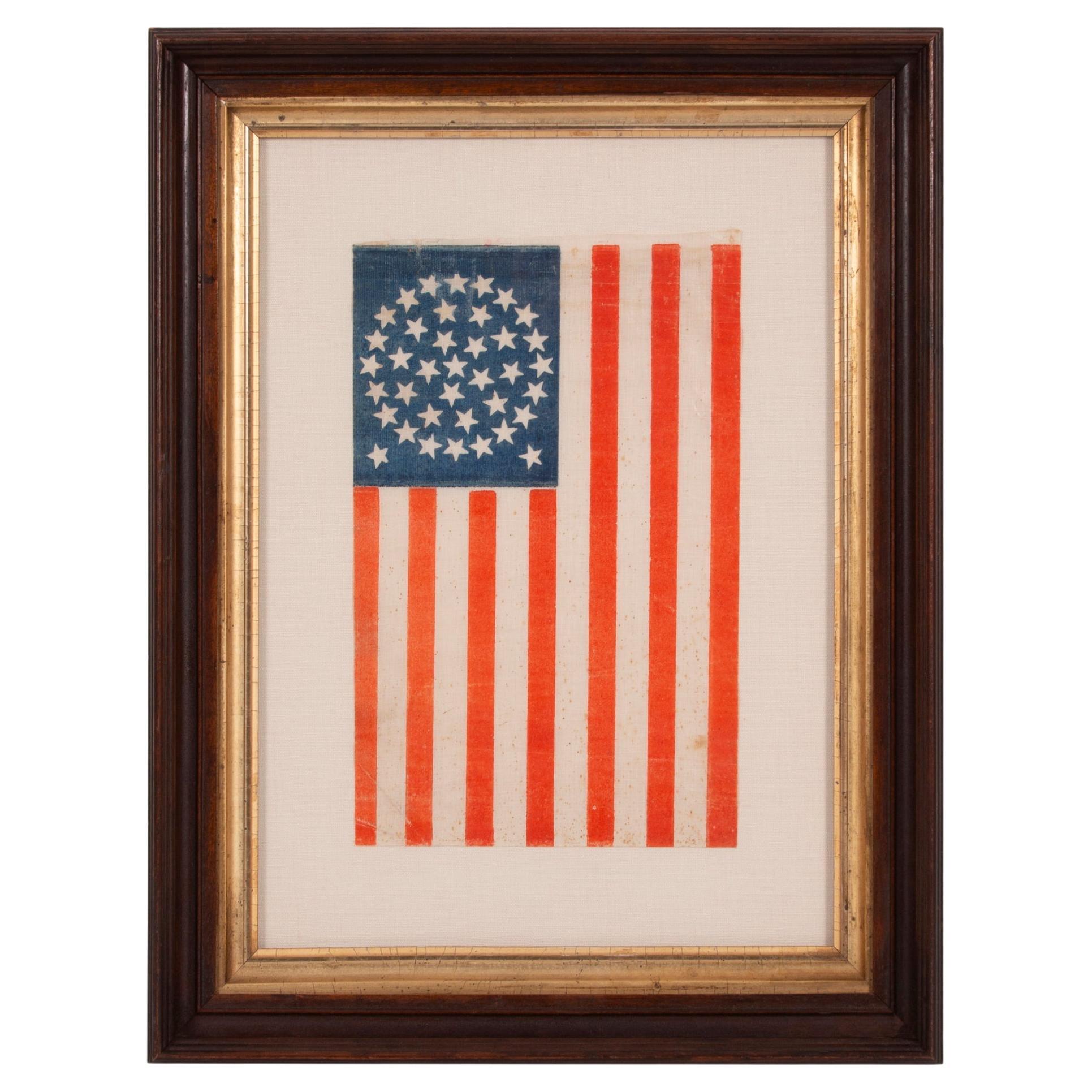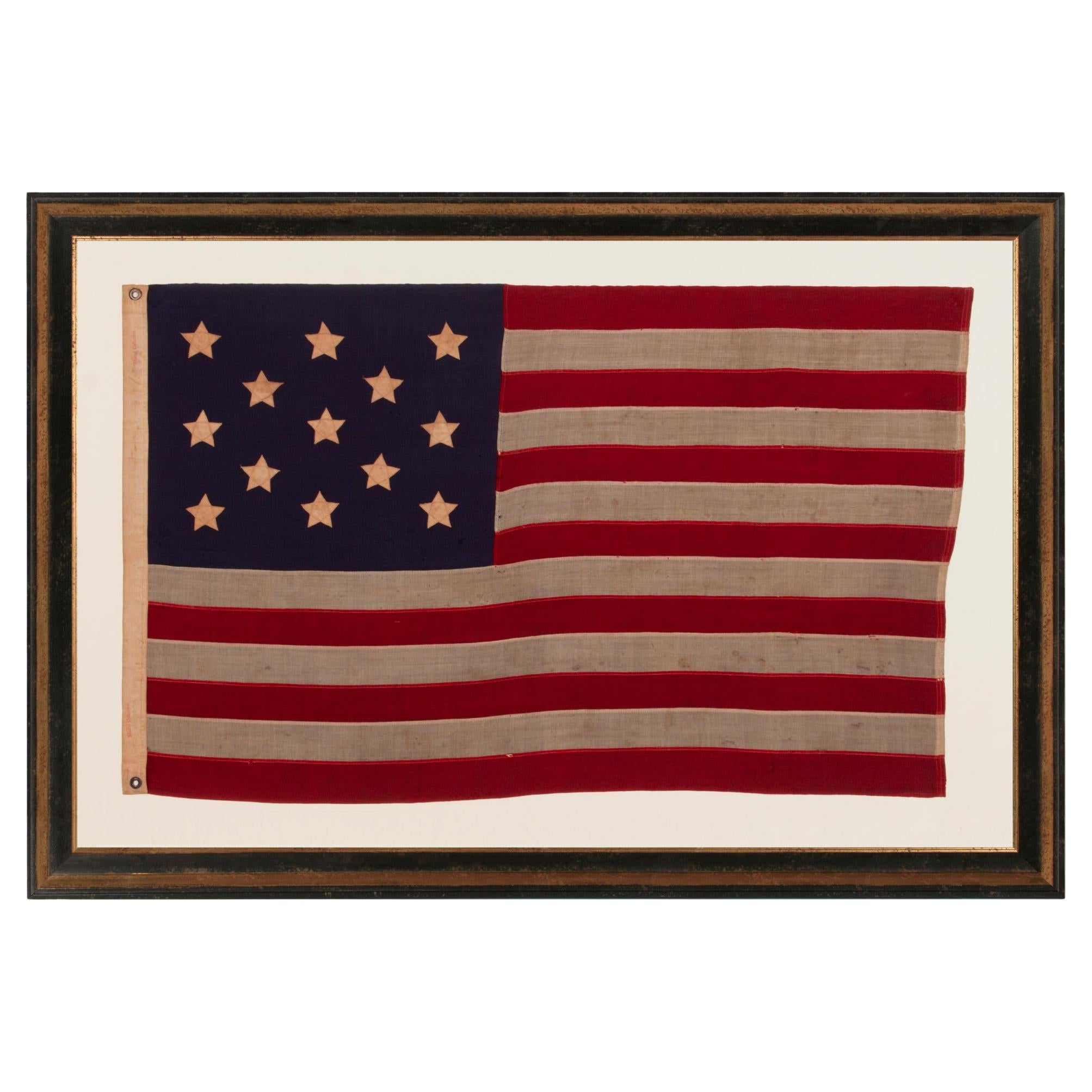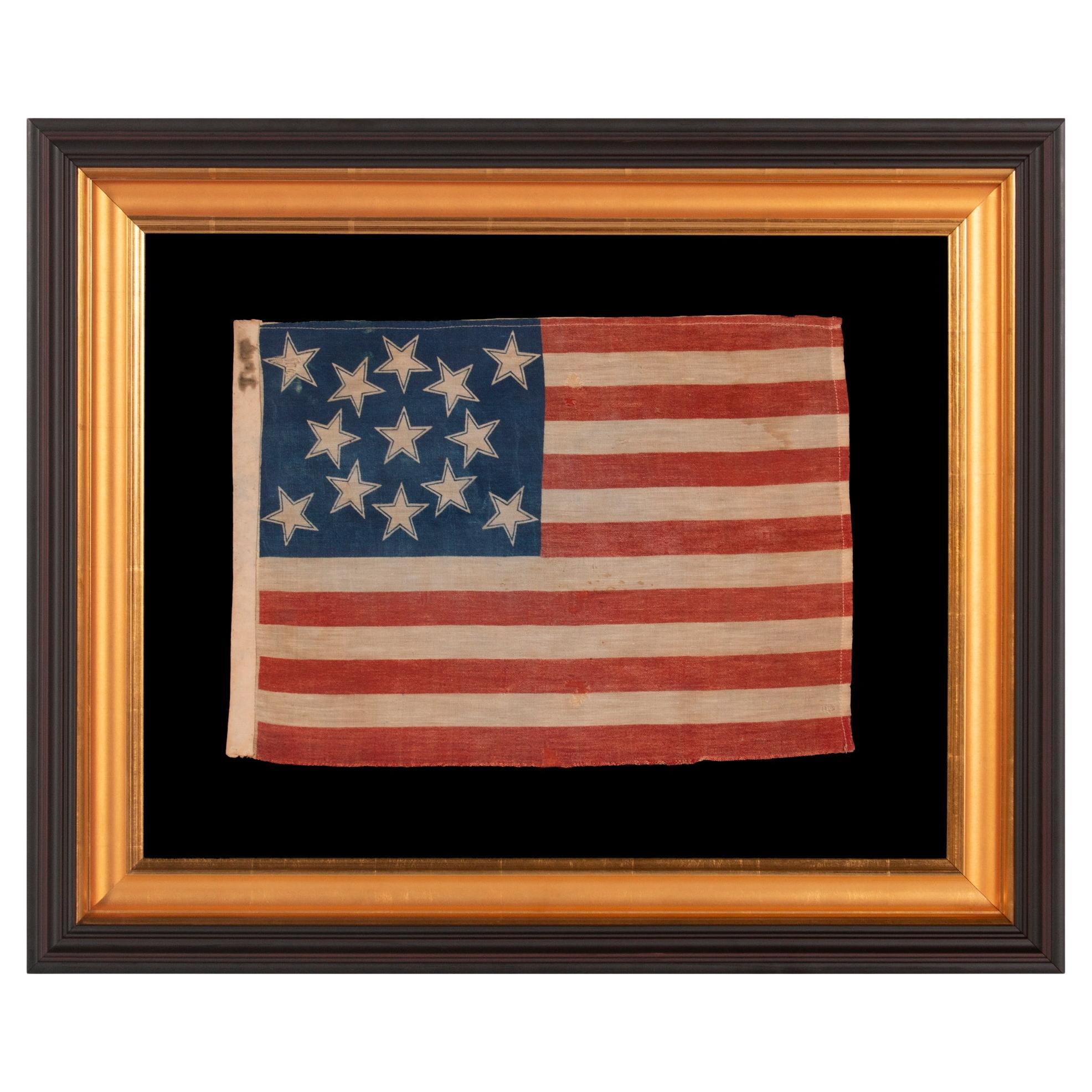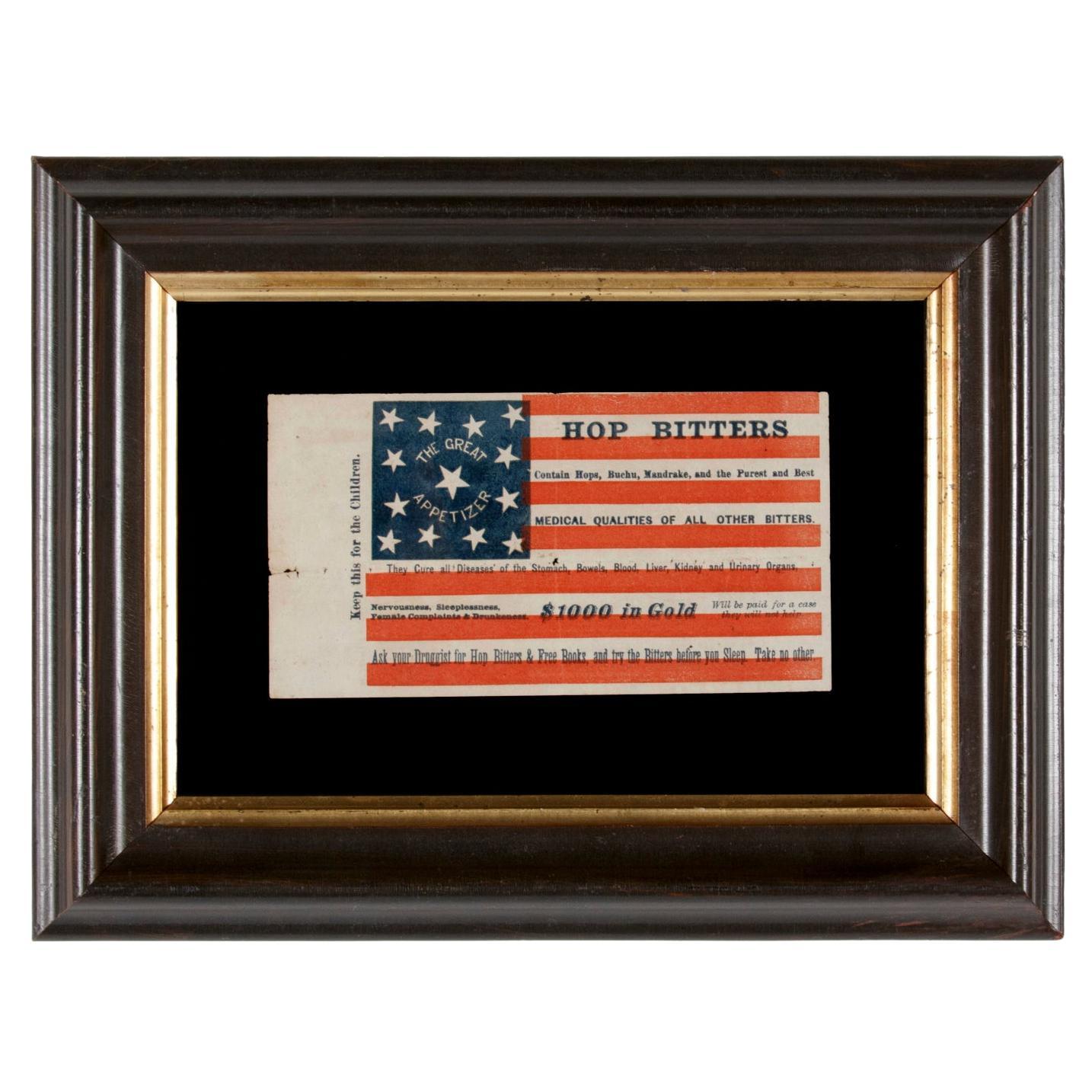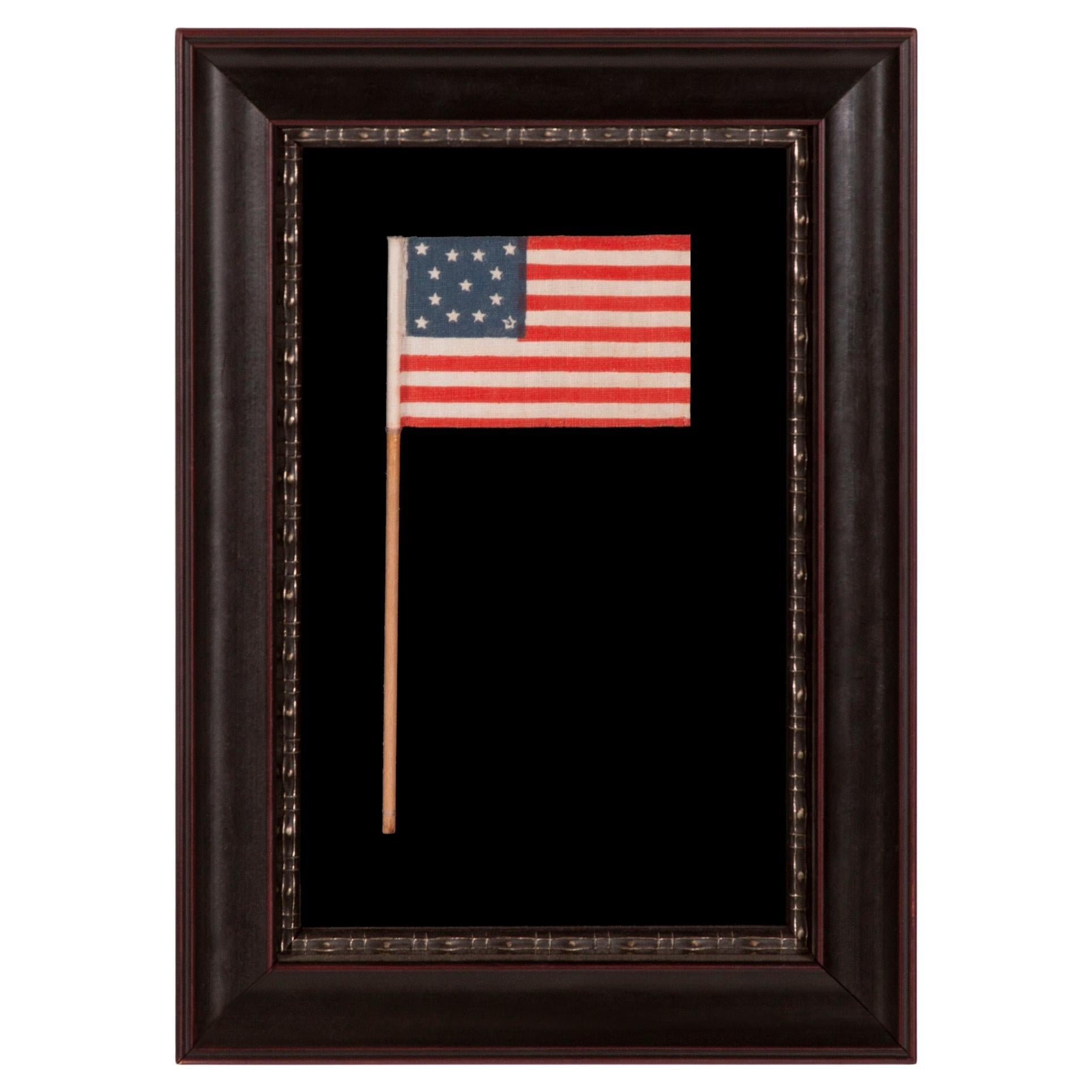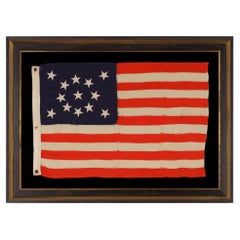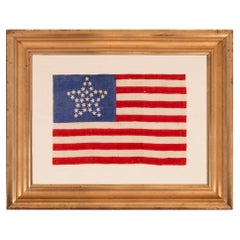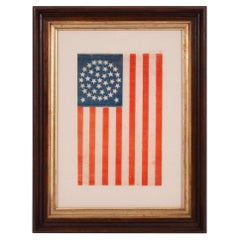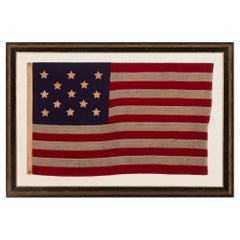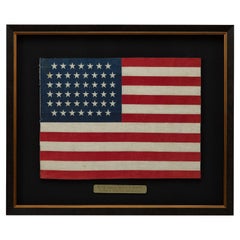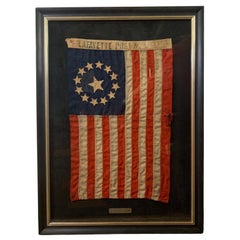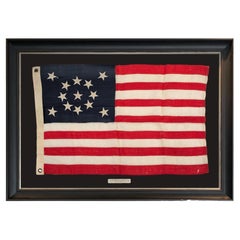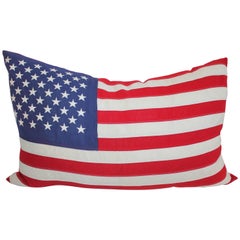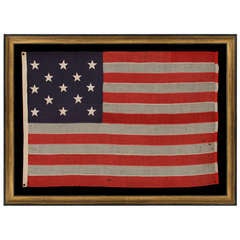
13 Star Flag In A 3-2-3-2-3 Configuration
View Similar Items
Want more images or videos?
Request additional images or videos from the seller
1 of 6
13 Star Flag In A 3-2-3-2-3 Configuration
About the Item
- Dimensions:Height: 58.5 in (148.59 cm)Width: 80 in (203.2 cm)
- Period:
- Date of Manufacture:1876-1890
- Condition:See Item Description.
- Seller Location:York County, PA
- Reference Number:Seller: web ID 13j-12901stDibs: LU8497980068
About the Seller
5.0
Recognized Seller
These prestigious sellers are industry leaders and represent the highest echelon for item quality and design.
Established in 1991
1stDibs seller since 2008
69 sales on 1stDibs
Typical response time: 11 hours
Authenticity Guarantee
In the unlikely event there’s an issue with an item’s authenticity, contact us within 1 year for a full refund. DetailsMoney-Back Guarantee
If your item is not as described, is damaged in transit, or does not arrive, contact us within 7 days for a full refund. Details24-Hour Cancellation
You have a 24-hour grace period in which to reconsider your purchase, with no questions asked.Vetted Professional Sellers
Our world-class sellers must adhere to strict standards for service and quality, maintaining the integrity of our listings.Price-Match Guarantee
If you find that a seller listed the same item for a lower price elsewhere, we’ll match it.Trusted Global Delivery
Our best-in-class carrier network provides specialized shipping options worldwide, including custom delivery.More From This Seller
View All13 Star Antique American Flag with Stars In A Medallion Configuration, 1895-1926
Located in York County, PA
13 STAR ANTIQUE AMERICAN FLAG WITH A MEDALLION CONFIGURATION OF STARS; A SMALL-SCALE EXAMPLE, MADE circa 1895-1926
This 13 star antique American flag is of a type made during the last decade of the 19th century through the beginning of the 20th. The stars are arranged in a medallion configuration that features a single center star, surrounded by a wreath of stars, with a flanking star in each corner of the canton.
The canton and stripes of the flag are made of wool bunting that has been pieced with machine stitching. The stars are made of cotton and double-appliquéd (applied to both sides of the flag) with a zigzag machine stitch. There is a twill cotton binding along the hoist with 2 white metal grommets. Along this are two black-inked stencils or stamps that read “Standard.” and “2 x 3,” to indicate in feet. Standard is a name brand of the maker and would have designated the grade of wool bunting, the type of binding, and other factors of the flag’s construction.
Why 13 Stars? As the number of stars grew with the addition of new states, it became more and more difficult to fit their full complement on a small flag. The stars would, by necessity, have to become smaller, which made it more and more difficult to view them from a distance as individual objects. The fear was that too many stars would become one white mass and distort the ability to identify American ships on the open seas.
The U.S. Navy used 13 stars on its small-scale flags for precisely this reason. This was, of course, the original number of stars on the first American national flag, by way of the First Flag Act of 1777, and equal to the number of original colonies that became states.
For all practical purposes, commercial flag-makers simply didn't produce flags with pieced-and-sewn construction that were 3 to 4 feet in length before the 1890's. There are exceptions to this rule, but until this time, the smallest sewn flags were typically 6 feet on the fly. The primary use had long been more utilitarian than decorative, and flags needed to be large to be effective as signals. Private use grew with the passage of time, however, which led to the need for long-term use flags...
Category
Antique Early 1900s American Political and Patriotic Memorabilia
Materials
Wool
33 Star Antique American Flag with a Great Star Configuration, ca 1859-1861
Located in York County, PA
33 STARS ANTIQUE AMERICAN FLAG WITH A "GREAT STAR" CONFIGURATION ON A BRILLIANT, INDIGO BLUE CANTON, A RARE AND EXTRAORDINARY EXAMPLE, PRE-CIVIL WAR THROUGH THE WAR'S OPENING YEAR, 1...
Category
Antique Late 19th Century American Political and Patriotic Memorabilia
Materials
Silk
38 Star Parade Flag with Stars in a Medallion Configuration, ca 1876-1889
Located in York County, PA
38 STARS IN A MEDALLION CONFIGURATION WITH 2 OUTLIERS, ON AN ANTIQUE AMERICAN FLAG WITH VIBRANT COLORATION, REFLECTS COLORADO STATEHOOD, 1876-1889, ILLUSTRATED IN “THE STARS & STRIPES: FABRIC OF THE AMERICAN SPIRIT” by RICHARD PIERCE, 2005
38 star American parade flag, printed on coarse, glazed cotton. The stars are arranged in a triple-wreath form of the medallion configuration, with a single center star and two stars flanking outside the basic pattern, toward the fly end. Most circular medallion patterns of this sort exhibit four flanking stars beyond the consecutive wreaths, one in each corner. The inclusion of only two was intentional, allowing for the easy addition of two more stars. Flag-makers knew that more Western Territories were soon to be added and eagerly anticipated their arrival. Use of fewer than four outliers was popular in 38 star parade flags, but is rarely encountered in other star counts.
Note how the vibrant, chromatic luster of the orange stripes provides striking contrast with the blue canton, and how this contributes to the flag's beautiful presentation. Many parade flags in this star count have red stripes that lean heavily toward orange. This was common across printed flags produced between the 1850's and the 38 star period, phasing out in the last decade of the 19th century.
Colorado became the 38th state on August 1st, 1876. This was the year of our nation’s 100-year anniversary of independence. Per the Third Flag Act of 1818, stars were not officially added until the 4th of July following a state's addition. For this reason, 37 was the official star count for the American flag in 1876. Flag-making was a competitive venture, however, and few flag-makers would have been continuing to produce 37 star flags when their competitors were making 38’s. It is for this reason that 38 and 13 stars (to represent the original 13 colonies) are more often seen at the Centennial International Exposition, the six-month long World’s Fair held in Philadelphia in honor of the event.
Some flag-makers would have been adding a star for the 38th state even before it entered the Union, in the early part of 1876 or even prior. In fact, many makers of parade flags were actually producing 39 star flags, in hopeful anticipation of the addition of two more Western Territories instead of one. But the 39th state would not join the Union for another 13 years, when the Dakota Territory entered as two states on the same day. The 38 star flag generally fell from use at that time, though it technically remained official until July 3rd, 1890.
President Ulysses S. Grant was in office when the first 38 star flags would have appeared. The list of presidents serving during the period when the 38 star flag was actually official, include Rutherford B. Hayes, James Garfield...
Category
Antique Late 19th Century American Political and Patriotic Memorabilia
Materials
Cotton
13 Star Antique American Flag , Ca 1890-1899
Located in York County, PA
13 STARS WITH SHORT, CONICAL ARMS ON A SMALL SCALE, ANTIQUE AMERICAN FLAG MADE DURING THE LAST DECADE F THE 19TH CENTURY; POSSIBLY OF PHILADELPHIA ORIGIN; FORMERLY IN THE COLLECTION ...
Category
Antique 1890s American Political and Patriotic Memorabilia
Materials
Wool
Price Upon Request
13 Star Antique American Parade Flag with Star in Snowflake Pattern, ca 1861-65
Located in York County, PA
13 STAR ANTIQUE AMERICAN PARADE FLAG, DATING TO THE CIVIL WAR PERIOD (1861-1865), OR PERHAPS PRIOR, WITH AN EXCEPTIONALLY RARE & BEAUTIFUL SNOWFLAKE MEDALLION CONFIGURATION
13 star ...
Category
Antique Mid-19th Century American Political and Patriotic Memorabilia
Materials
Cotton
13 Star Antique American Flag in a 3-2-3-2-3 Pattern, Brooklyn Navy Yard, 1903
Located in York County, PA
13 STAR ANTIQUE AMERICAN FLAG w/ A 3-2-3-2-3 PATTERN OF ESPECIALLY LARGE STARS; A U.S. NAVY SMALL BOAT ENSIGN, SIGNED & DATED 1903, MADE AT THE BROOKLYN NAVY YARD IN NEW YORK CITY
1...
Category
Early 20th Century American Political and Patriotic Memorabilia
Materials
Wool
You May Also Like
46-Star American Flag Printed in Drum Star Configuration
Located in Colorado Springs, CO
This is an original 46-Star American parade flag, celebrating Oklahoma statehood. Each star on the flag's canton represents a state in the Union at the time. The official flag design would update every July 4th, to include any new states added to the Union in the past year. Oklahoma, the 46th state, entered the Union on November 16, 1907. As such, this 46–star flag was the official flag of the United States from July 4, 1908, until July 4, 1912.
The silk flag has a dark blue canton with 46 white printed stars. The stars are printed in an 7-8-8-8-8-7 row configuration, or “Drum design.” The flag design is completed with 13 alternating red and white stripes, each stripe representing one of the original thirteen colonies.
The land that comprises Oklahoma today was added to the United States as part of the Louisiana Purchase of 1803. Throughout the 19th century, the U.S. government relocated Indian tribes from the southeastern United States to the area, and by 1900, over 30 Indian tribes had been moved to what was originally called the Indian Territories. At the same time, ranchers in Texas began to move into the area in search of new pasture lands. Although stipulations in the Indian Relocation Act agreed that the land would forever be Indian Territory, the promise of fertile farmland trumped the government’s promise of sovereignty.
On April 22, 1889, they opened the land to settlement by homesteaders, creating a land run in which settlers, called “Boomers,” were allowed to cross the Texas or Arkansas border at a particular hour to claim homesteads. Settlers who illegally crossed the border earlier to stake prime land were called “sooners,” which eventually became the state’s nickname. Wagons and the Santa Fe railroad carried cartloads of men and women to blank town sites and building plots, creating ten thousand-people communities in a matter of days. The following year, the region was further divided into Indian Territory and Oklahoma Territory...
Category
Vintage 1910s American Political and Patriotic Memorabilia
Materials
Silk
13-Star American Parade Flag, 1860
Located in Colorado Springs, CO
Presented is a stunning 13-star American parade flag, dating to 1860. The wool flag has 13 hand-sewn cotton stars with truncated tips. The stars are configured in the “Third Maryland” or “Cowpens” pattern, consisting of a 12-star wreath surrounding a large central star. The flag design is completed with 13 red and white alternating stripes and a white cotton hoist. The flag’s hoist has “Lafayette Post 140” stenciled in selvage.
The “Third Maryland” star pattern of a 12-star wreath surrounding a central star is associated with an early 13-star flag that was long thought to have been carried by William Batchelor of the 3rd Maryland Regiment at the Battle of Cowpens during the American Revolution. The flag, now in the collection of the Maryland State Archives, was later discovered by Smithosian experts to date to the mid-19th century. But this particular star pattern is forever linked to that particular 13-star flag and the wreath and central star configuration is still referred to as a “Third Maryland” or “Cowpens” style among dealers and collectors. Thirteen star flags with the “Third Maryland” pattern are among the scarcest and most desired by collectors of early American flag...
Category
Antique 1860s American Federal Political and Patriotic Memorabilia
Materials
Wool, Cotton
13-Star American Centennial Flag, circa 1876
Located in Colorado Springs, CO
Presented is a beautiful 13-star American Flag. This wool flag's canton features the highly sought-after medallion star pattern, with one large central star, encircled by a ring of e...
Category
Antique 1870s American American Colonial Political and Patriotic Memorab...
Materials
Brass
Large 48 Star Embroidered Flag Pillow
By American Flag & Banner Co.
Located in Los Angeles, CA
This monumental 48 star flag pillow is in great in great condition and has a red cotton linen pillow. The big pillow id down and feather fill.
Category
Mid-20th Century American Country Political and Patriotic Memorabilia
Materials
Cotton
$476 Sale Price
20% Off
39-Star Antique American Flag with 'Whimsical' Star Pattern, 1889
Located in Colorado Springs, CO
This is a 39-star unofficial American flag, handmade and printed on cotton. The flag dates to 1889 and has a unique history, thanks to its rare star-count.
The flag’s canton is prin...
Category
Antique 1880s American Political and Patriotic Memorabilia
Materials
Cotton
41-Star Printed Flag Waver, Celebrating Montana Statehood, 1889
Located in Colorado Springs, CO
Presented is a very rare, 41-star flag waver celebrating Montana statehood. The flag is printed on linen and dates to 1889. The dark blue canton is printed with forty one stars in nine rows of alternating counts of five and four stars. Thirteen red and white stripes complete the flag’s design.
The history of Montana statehood is a long one. Numerous Native American tribes originally inhabited the Montana Territory. Meriwether Lewis, William Clark, and the members of their expedition were the first explorers to document a journey through Montana and the lands of the Louisiana Purchase. Soon, forts were established to facilitate regular fur trading with Native American tribes. Missionaries and trailblazers followed.
The discovery of gold in the early 1860s sped the creation of the Montana Territory. As settlers and gold prospectors entered Montana in the 1860s and 1870s, conflicts with the Native Americans arose. Perhaps the most famous clash between Native Americans and the United States military occurred in Montana on June 25, 1876. On that day, Sioux and Cheyenne defeated Lieutenant Colonel George Armstrong Custer‘s 7th United States Cavalry regiment at the Battle of the Little Bighorn. A year later, Nez Percé Chief Joseph surrendered in the Bear Paw Mountains of Montana. Lured by copper in the 1880s, mining brought even more settlers to Montana. Rich grazing lands for cattle and sheep attracted other pioneers.
Each of the states in America, with the exception of the original thirteen, Texas, and California, was first organized as a territory before achieving admittance to the Union as a state. Originating with the Ordinances of 1785 and 1787, the territorial system provided the expanding U.S. with a method to govern frontier areas until they gained sufficient population and economic maturity to qualify for statehood. Not surprisingly, residents of frontier territories usually demanded quick admission to statehood so they could gain full control of their local governments. Montana was a territory for 25 years – from the creation of Montana Territory in 1864 until the territory was admitted to statehood in 1889.
On November 2, 1889, North and South Dakota were added to the Union as the 39th and 40th states, the first time in history that two states were admitted on the same day. Montana became the 41st state on November 8, predating Washington, the 42nd state, by only three days. Flag makers were not in the business of making out-of-date flags. As a result of these rapid changes in the number of states, only a small number of 41-star flags or commemorative items were ever produced, thereby making any 41-star flag exceedingly rare.
CONDITION:
Good condition. This flag is printed, with a hemmed headband and fly end in a running stitch...
Category
Antique 1880s American Political and Patriotic Memorabilia
Materials
Linen
